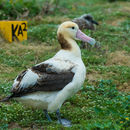Biology
provided by Arkive
The short-tailed albatross arrives at its colonial nesting sites in large numbers in mid October (5). Each pair returns to the same nest as in previous years, where they court using vocalisations and displays. The nests are lined with grass and a single, large egg is incubated by both sexes for 65 days, alternating shifts whilst the other member of the pair forages to feed them both (3). The chick hatches between January and February (5) and is guarded and fed regurgitated food from both parents (3). The chick fledges between May and June and reaches sexual maturity at four years. It will not nest until six years, by which time it will have established a life-long pair bond. Successful breeders will leave the breeding grounds in May and June, but failed breeders and non-breeders leave before the new chicks have hatched (5).
Feeding mainly at night due to its diet of squid, the short-tailed albatross may also eat fish and crustaceans. It is often seen feeding behind fishing vessels, picking waste from the surface (5).
Conservation
provided by Arkive
A feather-collection ban was imposed in 1906, but it was not effective. Collection only began to dwindle when numbers of the short-tailed albatross dropped so low in the 1930s that it was no longer economically worth hunting (6). It is now legally protected in both Japan and the United States, and the island of Toroshima has been established as a National Wildlife Protection Area. Toroshima has also benefited from the transfer of native plants onto the island to enhance the nesting sites. Decoys were used to attract short-tailed albatrosses to a new site on Toroshima, and by 2003, six chicks had fledged from this site. Crucially, measures to prevent entanglement in fishing gear and to mitigate longline fishing need to be introduced if this albatross, and others, are to survive (2).
Description
provided by Arkive
Named for its short, white tail with a black bar at the end, this seabird begins life with blackish brown feathers and pale pinkish-yellow legs. As it matures, the feathers turn white, leaving only black edges to the wings and a hint of dull orange on the crown and nape (2). The feet of adults are pale blue (3) and the bill is large and pink, gaining a blue tip with age (2).
Habitat
provided by Arkive
A pelagic species for most of the year, the short-tailed albatross is found on bare ground surrounded by cliffs at the nesting grounds. It previously nested in open areas (5).
Range
provided by Arkive
The short-tailed albatross breeds on Torishima and the Senkaku Islands, Japan. It previously also bred on several other Japanese islands, as well as islands off the coast of Taiwan. Its marine range covers much of the northern Pacific Ocean and the Sea of Okhotsk. It has been recorded along the coasts of Japan, eastern Russia, South Korea, China, Alaska, and the Northwestern Hawaiian Islands, as well as down the west coast of the United States (2).
Status
provided by Arkive
The short-tailed albatross is classified as Vulnerable (VU) on the IUCN Red List 2007 (1) and is listed on Appendix I of the Convention on Migratory Species (CMS or Bonn Convention) (4). It is also listed as Endangered by both the United States and Japan (3).
Threats
provided by Arkive
In Japan the short-tailed albatross is known as 'Ahodori' meaning 'fool-bird', as they would remain at their nest sites as humans walked through the breeding grounds killing them for their feathers (6). The behaviour of the Japanese feather collectors lead to the dramatic decline of this species during the 19th and 20th Centuries, culminating in its putative extinction in 1949. Fortunately, the short-tailed albatross was rediscovered in 1951, after feather-collecting had ceased due to lack of birds. Today, the enormous threat posed to many species of seabird is present for this species also – mortality caused by fishing industry practices, such as longlining. Compounding this threat is the instability of soil at the breeding sites, brought about by deforestation. Some authorities also believe that the species is now most vulnerable to natural disasters, particularly volcanic eruptions (2). The majority of the population breeds at one site (2), where the entire human population of 125 people was lost at once by an eruption in 1902 (6).

